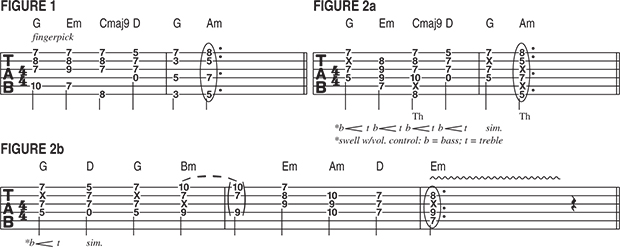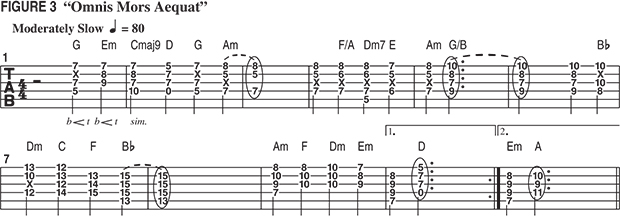Steve Morse Lesson: Bach Chorale Voicings
In this classic Steve Morse lesson, learn an approach to chord playing inspired by Johann Sebastian Bach’s chorales.

This column is taken from the May 2007 issue of Guitar World.
This month, I’d like to focus on an approach to chord playing inspired by Johann Sebastian Bach’s chorales. As a musical form, the chorale originated as a vocal hymn of the Lutheran church, often constructed in four-part harmony wherein the top voice is the melody. Bach composed many chorales of incredible beauty; the way he harmonized for four voices was impeccable, and his chorales served as the textbook for studying Western harmony for over 100 years.
One of the compositional devices Bach used when writing chorales is the common tone, which is a note within the four-part harmony that stays the same when one chord changes to the next. The practice of having notes remain unchanged from chord to chord, or moving them as little as possible, to the closest chord tone, is known as voice leading.

Inspired by Bach’s chorale writing style, I composed a piece called “Omnis Mors Aequat,” which in Latin means, “All things are equal in death.” I recorded it for four voices, but it began as an instrumental guitar piece. FIGURE 1 depicts the first six chords of the piece: the first three chords, G-Em-Cmaj9, all include the same top two notes, as the note on the G strings moves from D to E and then back to D. While these “voices” on the top three strings remain mostly unchanged, the bass notes descend from G to E to C, thus dictating the chord movement.

When playing this type of idea on electric guitar, I like to use the tone control to swell into each chord. I begin with the tone control rolled down to full bass, and as I strum across the chord with the pick, I simultaneously use my pick-hand pinkie to turn the volume control from bass to treble, creating a sort of “French horn in the distance” effect. This is illustrated in FIGURE 2a. I simply grab as many notes as I can with the fret-hand, usually three or four depending on the specific chord voicing. FIGURE 2b shows another sequence of chords played in the same manner.
FIGURE 3 depicts the first 20 bars of “Omnis Mors Aequat,” wherein each chord is played with a tone swell. Following the first six chords, bars 3 and 4 present the next six chords. Notice that the first three chords here, Am, F/A and Dm7, share a high C note on top. If you now look at the first five chords, you will see that, as the bass notes move around, the higher voices either remain constant or move only a half step or whole step up or down. Now play through the rest of the progression through the first ending, taking notice of the voice leading—the notes that stay the same versus the notes that change. The first nine bars are then repeated, followed by a different ending wherein the progression resolves nicely to an A major chord.
In chorale music, the four voices move independently, and the only thing to think about when writing in this style is what it’s going to sound like, because you’re not limited to the confines of a specific instrument. Voicing chords on the guitar this way sounds cool and unusual because it’s very un-guitaristic and enables one to break away from the more familiar sound of the way chord progressions are typically played on guitar. In chorales there are often wide intervallic gaps between the voices, and in bar 4 of FIGURE 3, for example, the third string is muted. while notes are fretted on the strings on either side of it, creating a spacious, open sound.
Looking at the piece as a whole, you’ll discover that there are only a few variations in the chord voicings used. Try experimenting with the ordering of these voicings to create your own original chord progressions. It’s chiefly the way the bass line moves against the melody that creates the characteristic chorale-like sound.

Also, depending on how your guitar/amp combination sounds, you might want to change the voicings to different strings. FIGURE 4 shows two different ways to voice Cmaj9; FIGURE 5 offers another example of this concept, using wider stretches.
If you were raised on rock and roll like I was, something like this represents a big departure. This is all the more reason to try it. It may take some work to get a sound you like. For a start, use a clean sound and your guitar’s bridge pickup, and try adding a compressor and some long delay.
Get The Pick Newsletter
All the latest guitar news, interviews, lessons, reviews, deals and more, direct to your inbox!
“There are so many sounds to be discovered when you get away from using a pick”: Jared James Nichols shows you how to add “snap, crackle and pop” to your playing with banjo rolls and string snaps
Don't let chord inversions bamboozle you. It's simply the case of shuffling the notes around







![Joe Bonamassa [left] wears a deep blue suit and polka-dotted shirt and plays his green refin Strat; the late Irish blues legend Rory Gallagher [right] screams and inflicts some punishment on his heavily worn number one Stratocaster.](https://cdn.mos.cms.futurecdn.net/cw28h7UBcTVfTLs7p7eiLe.jpg)


